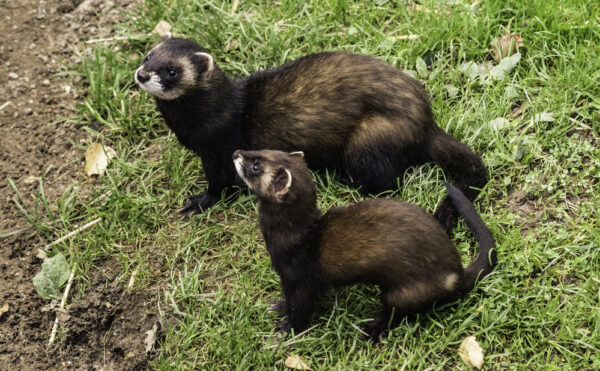
What is a Polecat? Unveiling the Mysterious Mustelid
About Polecats
Polecats are small carnivorous mammals belonging to the Mustelidae family, which also includes species such as weasels, badgers, and otters. The European polecat, also known as Mustela putorius, is one of the most well-known members of this family.
These creatures have long, slender bodies and short legs, with fur that varies in color from dark brown to black. Their distinctive facial markings consist of a white or cream-colored mask around their eyes and mouth. Polecats are known for their strong, musky odor, which is produced by scent glands located near their genitals. This odor acts as a defense mechanism against predators and plays a role in communication during mating season.
Polecats are predominantly nocturnal and inhabit a wide variety of habitats, from forests and grasslands to wetlands and agricultural areas. They are versatile predators, with a diet primarily consisting of small mammals such as rabbits, rodents, and birds. Occasionally, polecats may also prey on amphibians, reptiles, and insects.
The biology of the polecat has been studied extensively in various research papers, including topics such as its ecological significance, distribution, and population density. Studies on the home ranges and movement patterns of polecats have revealed insights about their territorial behavior and habitat preferences.
Despite their adaptability to different environments, polecats face several threats due to human activities such as habitat loss, poisoning from rodenticides, and road mortality. Conservation efforts, including habitat restoration and monitoring of populations, are important to ensure the survival of this unique and fascinating mammal.
Physical Characteristics
General Appearance
The Polecat, scientifically known as Mustela putorius, is a member of the mustelid family. It has a distinctive appearance with a dark fur coat and a characteristic mask-like face marking. The body is elongated, and the tail is moderately bushy, adding to its unique appearance. The Polecat’s ears are small and rounded, playing a role in its overall morphology.
Size and Weight
Males and females exhibit differences in both size and weight. Males typically have a body length of 35-45 cm, while females are slightly smaller, with a body length of 30-40 cm. The tail length in males can range from 12 to 19 cm, whereas, in females, it can vary from 11 to 17 cm. In terms of weight, male polecats are usually heavier, weighing between 1 to 1.5 kg, while females weigh around 0.8 to 1.2 kg.
The Polecat’s home range size can vary greatly, depending on factors such as habitat availability and individual requirements. However, on average, their home range spans over an area of about 181 hectares. The overall appearance, size, and weight of the Polecat make it a unique and interesting creature within the Mustela genus.
Classification and Types
Polecats are small carnivorous mammals belonging to the Mustelidae family within the order Carnivora. They are part of the Mammalia class and can be found in various regions across the world. The different types of polecats include the European polecat, steppe polecat, American mink, and the black-footed ferret.
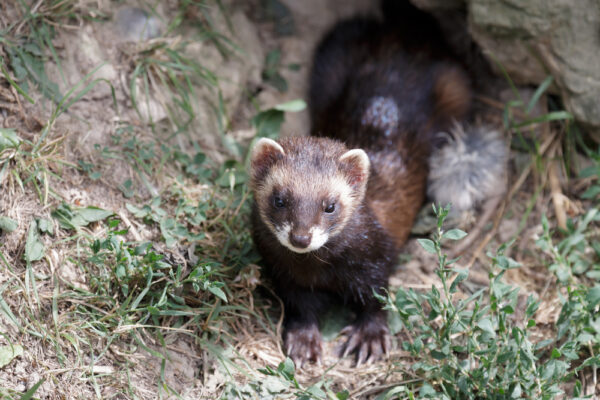
European Polecat
The European polecat, scientifically known as Mustela putorius, is native to England, Wales, Ireland, Scotland, and Eurasia. This species is primarily nocturnal and inhabits a mixture of habitats ranging from woodlands to marshes and grasslands. The diet of European polecats mainly consists of small mammals, birds, and occasionally amphibians and insects. European polecats are known for their distinctive appearance, which includes a dark coat, lighter underfur, and a white mask-like marking on their face.
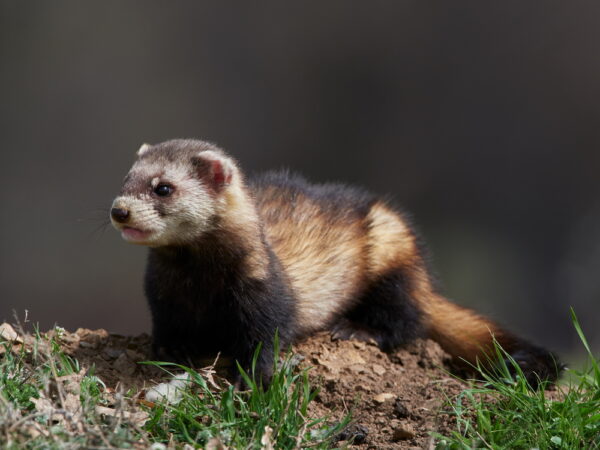
Steppe Polecat
The steppe polecat, also known as Vormela or M. eversmanni, is native to the Western Palearctic region, which spans across Europe and Asia. These polecats prefer open habitats, such as steppes, grasslands, and deserts, where they hunt for small mammals, birds, and reptiles. Steppe polecats have a somewhat similar appearance to the European polecat, but with a lighter coat and facial markings, adapting better to arid terrain.
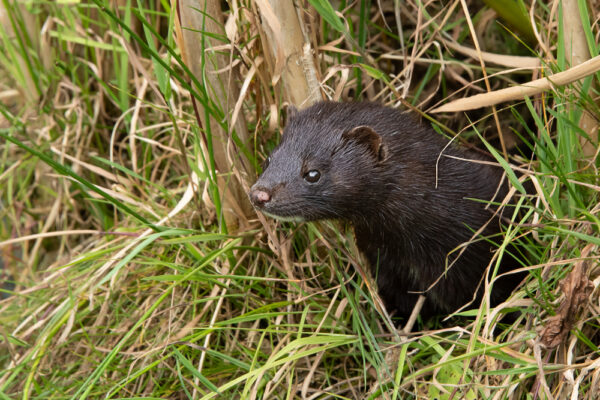
American Mink
The American mink is another member of the Mustelidae family, though not a true polecat. Native to the United States, these semi-aquatic creatures can be found along rivers, streams, and lakes. They have a slender, elongated body, and their fur varies in color from dark brown to black. Known for their adaptability, they feed on a diverse diet consisting of fish, birds, small mammals, and invertebrates. American minks have been introduced to Europe, where they pose a threat to native wildlife and polecats due to competition and interbreeding.
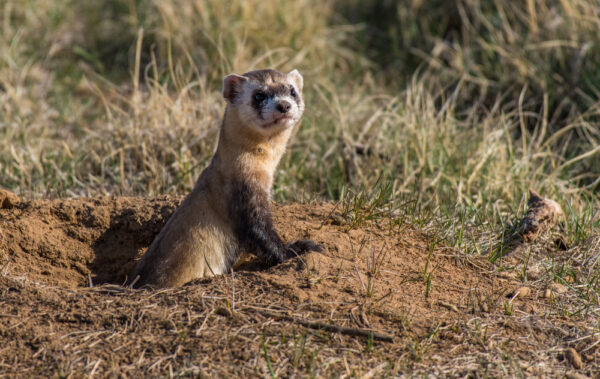
Black-Footed Ferret
The black-footed ferret is another member of the mustelid family native to North America. This endangered species is closely related to polecats and inhabits prairies and grasslands. Their diet primarily consists of prairie dogs, which they hunt for in burrows. Black-footed ferrets have a distinctive appearance with a black mask, black feet, and a cream-colored coat with dark patches.
In conclusion, polecats are fascinating carnivorous mammals that play an important role in maintaining biodiversity and controlling rodent populations in their respective ecosystems. Their unique adaptations and wide distribution make them an intriguing group of species within the Mustelidae family.
Habitat and Distribution
Polecats are small carnivorous mammals belonging to the Mustelidae family. They thrive in various habitats across North America, Asia, and parts of Europe, including England. The habitats they occupy are diverse, ranging from dense forests to valleys and agricultural lands.
In Europe, the steppe polecat (Mustela eversmanii) has been observed to have a diverse range of habitats, including grasslands, brushlands, and semi-desert areas. According to a study on their population status, they appear to be flexible in their use of different habitats, allowing them to adapt to changing environmental conditions.
Similarly, the European polecat (Mustela putorius) inhabits varying landscapes. They are often found in regions with dense forest cover and areas near water sources, but their distribution can extend to agricultural and urban landscapes as well. Research on the spatial distribution and habitat selection of polecats shows a preference for environments with good cover, prey availability, and resting sites.
While polecats are not commonly found in mountainous regions, their distribution does cover valleys that provide essential resources such as water, food, and shelter. In the United States, polecats are commonly referred to as skunks, which are also part of the Mustelidae family and share similar habitat preferences.
Polecats’ ability to adapt to different environments has enabled them to maintain a stable distribution across their native regions. However, their populations may still face challenges due to human encroachment, habitat destruction, or prey availability. By monitoring and understanding the varied habitats and distribution of polecats, conservation efforts can be directed towards preserving these unique and adaptable creatures.
Diet and Hunting Behavior
Polecats are carnivorous predators, known for their hunting abilities and diverse diet. They mostly rely on small mammals, such as rodents and rabbits, but also consume birds, frogs, fish, and eggs, depending on their habitat and prey availability.
The hunting strategy of polecats is characterized by their stealth and agility, allowing them to capture various types of prey with ease. One of the key features of their predatory behavior is the ability to search for and locate their quarry effectively. Polecats are mostly nocturnal, which means they typically hunt during the night, when small rodents and other prey are active.
Rodents make up a significant portion of a polecat’s diet, due to their abundance and accessibility in various habitats. Polecats are known to hunt for mice, voles, and rats, often targeting these small mammals in their burrows and nests. However, polecats sometimes show different preferences in their diet, depending on the region they inhabit. For instance, in Mediterranean regions, they have been observed to specialize in the consumption of wild rabbits.
Birds, another important part of a polecat’s diet, are hunted both on the ground and in trees. Polecats are capable of climbing trees to catch birds in their nests, while also targeting ground-dwelling avian species. Frogs and fish are less frequent prey items, but polecats have been known to catch them in wetland habitats when other food sources are scarce.
Besides hunting live prey, polecats are also opportunistic feeders, which means they will readily consume carrion and eggs when available. This dietary flexibility helps polecats survive in a wide range of habitats and allows them to adapt to changes in prey populations.
In conclusion, a polecat’s diet is primarily made up of small mammals, birds, and occasional amphibians and fish. They are skilled hunters, known for their stealth and adaptability, allowing them to capture various types of prey and thrive in different habitats.
Reproductive Behavior
Polecats exhibit interesting reproductive behavior throughout different stages of their life. They have a polygynous mating system, where males often mate with multiple females in the breeding season. As the mating season commences, male polecats experience a surge in testosterone, leading to an increased display of reproductive behaviors.
The breeding season for polecats is typically from late winter to early spring, with females giving birth to their young after a gestation period of about 40-45 days. However, delayed implantation has been observed in some species like the marbled polecat. In such cases, implantation of the blastocyst in the uterus is postponed, leading to a prolonged gestation period.
Female polecats usually give birth to a single litter per year, consisting of 3 to 7 young. Newborn polecats are born in a helpless state, with their eyes and ears closed, and rely on their mother for their survival. Post-natal growth is rapid, with the young developing vital physical capabilities such as vision, hearing, and mobility within a few weeks.
Both males and females contribute to the care of their offspring. While females are responsible for nursing, grooming, and protecting their young, males also play a role in the upbringing of their offspring by providing resources and helping to maintain the den. However, parental care in polecats is not always exclusive. For instance, domestic ferrets have been observed to readily accept and nurture neonatal polecat kits.
In summary, polecats exhibit intriguing reproductive behaviors and life cycle adaptations that ensure the successful upbringing of their young. Their mating system and the role of both males and females in raising offspring are essential aspects of their reproductive biology.
Predators and Threats
Natural Predators
Polecats, being carnivorous animals, have a variety of natural predators that pose threats to their survival. Some of their most common predators include larger carnivores such as badgers, foxes, and certain birds of prey. While polecats are skilled hunters and adept at catching their preferred food sources, which include small mammals like rodents, rabbits, and birds, they also become prey for these larger predators.
Smaller members of the Mustelidae family, such as weasels and stoats, may also occasionally pose threats to polecats. However, polecats generally tend to be at a higher risk from larger predators that are more likely to target them.
Human Impact
Human activities have a significant impact on polecats and their habitats. Persecution by gamekeepers, farmers, and the general public has historically been a major threat to their populations. Polecats have often been targeted as a result of their predation habits on game birds and domesticated animals such as poultry and even sometimes small livestock like young deer. This has led to decreased polecat populations in certain regions.
In addition, inadvertent harm can occur through various means. For example, polecats may get caught in traps or snares aimed at other species, or become victims of road accidents while moving between fragmented habitats. Moreover, habitat destruction and degradation due to human activities such as deforestation and urbanization can limit the availability of suitable environments for polecats.
To conclude, while polecats face threats from a variety of predators, both natural and human-induced, it is crucial to recognize these challenges and implement conservation strategies to ensure the long-term survival and sustainability of their population.
Status and Conservation
The European polecat, known scientifically as Mustela putorius, is a species that has been relatively neglected when it comes to conservation efforts. In many countries, such as Italy and Spain, it is not considered a priority for conservation or management due to a perceived lack of economic importance or potential cultural significance.
However, research into the polecat’s genetic structure has revealed that conserving the species is vital to maintain its biodiversity. Differences in the genetic makeup of various polecat populations across Europe have been observed, and these variations may hold the key to understanding the species’ phylogeographic structure.
The population status of the polecat differs among European regions. Some areas have seen declines in the species’ numbers, while in others, the populations remain relatively stable. It’s important to take an active role in conservation efforts to ensure the long-term survival of these creatures. In some areas, conservation measures seem to be improving the species’ situation. For example, in Luxembourg, the implementation of favorable conservation state regulations has protected the polecat from hunting and other human-related threats.
To address the conservation needs of the polecat throughout its range, it is crucial to assess its current status and population distribution. This information will help guide practical and effective conservation and management strategies to ensure the polecat remains a part of Europe’s rich biodiversity. Developing partnerships between researchers, conservationists, and local governments will be essential to ensure proper steps are taken to preserve and protect this species.
It’s important to recognize that each case requires a tailored and adaptive approach – one that takes into account the unique conditions of each region, including the local polecat populations’ genetic structure and the environmental factors at play. Through collaborative efforts and informed decision-making, it is possible to develop strategies that will help ensure a positive future for the polecat and its crucial role in the ecosystem.
Special Characteristics
Polecats are small carnivorous mammals that are closely related to the domestic ferret. They possess some unique features that set them apart from their mustelid cousins.
Scent Glands
One of the most distinct features of polecats is their powerful scent glands. These glands produce a foul-smelling odour which is used for several purposes such as marking territory and warding off potential predators. The scent glands are located near the base of the tail and can be identified by a greenish-yellowish secretion. This strong odour is one of the key ways in which polecats can be distinguished from their domestic ferret counterparts.
Night Behavior
Polecats are primarily nocturnal creatures, meaning they are most active during the night. They rely on their keen sense of smell to locate prey in the darkness. Their diets primarily consist of small mammals like rodents, but they are also known to consume birds, frogs, and insects. Polecats use their sharp teeth and powerful jaws to subdue their prey and, like many other nocturnal predators, they have excellent night vision.
They establish dens, also known as burrows, in various types of environments, including grasslands, woodlands, or even abandoned buildings. These dens act as a safe haven for polecats, providing protection from potential threats and a place to raise their young. It’s not uncommon for polecats to share dens with other species, such as rabbits or badgers, as a means of maximizing the use of the available space in their territory.
Miscellaneous Facts
Polecats, belonging to the Mustelidae family, have played fascinating roles throughout history and possess various unique characteristics. In the natural world, polecats have a lifespan of around five years, preying on small mammals like rabbits and hares, making them an essential part of the ecosystem. They have keen eyesight and are well-adapted to nocturnal hunting, using their sharp eyes to detect prey even in low light conditions.
Polecats have several distinguishing features, such as their elongated necks, which enable them to explore narrow, underground burrows while searching for food. Another characteristic feature is their pungent smell, produced by their anal glands, which deters predators and marks their territory. It is worth noting that fur farmers in the early 20th century bred polecats with ferrets to create a more docile animal suitable for fur production and domestication.
In terms of historical references, polecats have been present in various European regions for centuries, making them an integral part of the continent’s fauna. As the eradication of certain species throughout the ages impacts ecosystems, it is important to understand their critical role in maintaining a balanced environment. Both ecological and cultural factors contribute to the decline of certain species, thus making conservation efforts crucial in preserving and restoring native habitats.
By exploring these miscellaneous facts about polecats, we can better appreciate their significance in the natural world and acknowledge the importance of maintaining biodiversity for the health of ecosystems and the vibrant history they encompass.
Frequently Asked Questions
What is the difference between a mink and a polecat?
Minks and polecats are two different species of carnivorous mammals belonging to the Mustelidae family. Minks are usually smaller and slender in comparison to polecats. While both have long bodies and short legs, polecats have a more distinct mask-like facial pattern, and minks have a more uniform coloration. Polecats are primarily found in Europe, whereas minks exist in both Europe and North America.
Are polecats a threat to pets?
Polecats are not typically a threat to pets like cats and dogs but may pose some risk to smaller animals like rabbits and poultry. They are known to hunt and eat small mammals and birds, so it is best to keep an eye on your pets and secure their habitats if you live in an area with polecat sightings.
How large do polecats grow?
Polecats grow to an average body length of 18 to 20 inches (45-51cm) and have a tail that adds an additional 5 to 6 inches (12-15cm). Their weight varies between 1.5 and 3.5 pounds (700-1600 grams), depending on factors like age, gender, and habitat.
What does polecat symbolism represent?
In folklore and mythology, polecats have been associated with aspects like cunning, resourcefulness, and adaptability. They are often regarded as solitary animals with strong survival instincts, symbolizing resilience and independence.
What does the term ‘polecat’ mean in Southern slang?
In Southern US slang, the term “polecat” is sometimes used as an alternate name for a skunk. This usage likely stems from their similar scent and European settlers’ confusion between the two distinct species.
What is the relationship between skunks and polecats?
Although skunks and polecats both produce a strong-smelling, defensive musk, they are not closely related species. Skunks belong to the Mephitidae family, while polecats are part of the Mustelidae family. The term “polecat” is sometimes mistakenly used, particularly in Southern United States slang, to describe a skunk due to their similar odor and appearance.